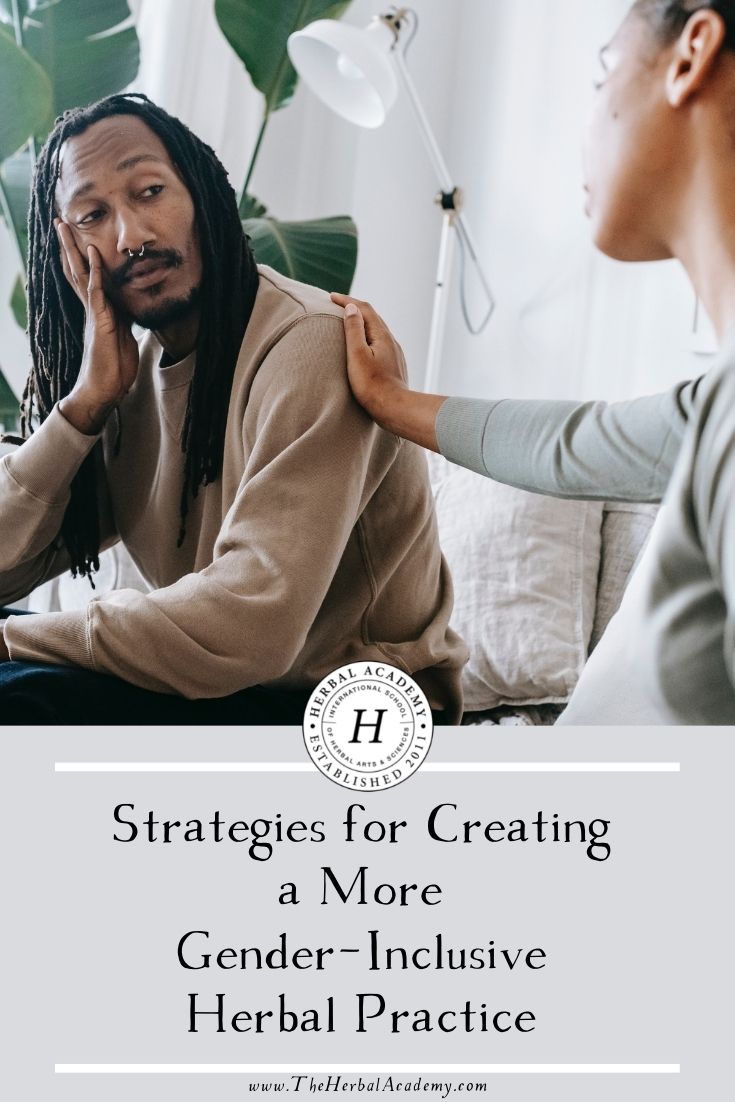
Strategies for Creating a More Gender-Inclusive Herbal Practice
This post is co-authored by Linden de Voil R.H.
You are reading Part 2 of a series on how to make your herbal practice, classes, or books more accessible to transgender clients. In Part 1, we talked about the harms trans people experience in conventional health care and the difficulties in even accessing that care, as well as some of the ways herbalism might be particularly healing to those with medical trauma. Part 1 also gave some important criteria to help decide if you’re prepared to work with trans clients as a practitioner. If you haven’t read Part 1, we highly recommend starting there, to understand the context in which trans clients might be coming to your practice.
Now let’s get into some of the practical steps you can take to make your herb clinic or classes safer and more accessible for trans people! This post gives you some specific gender-related shifts you can make to avoid harming or turning off clients who are trans. We will also touch on some of the other obstacles you can address, many of which may disproportionately affect your trans clients. We hope this will help give you a starting place as you work to make your practice a more welcoming space for anyone in need of care!

Intake Forms
One of the most fundamental ways we can respect our clients is by using their correct name and pronoun. In order to do that, we have to make sure we know what it is, rather than assuming based on their appearance or what’s on their medical records and other documents. Intake forms are a great way to initially collect this information from clients. (If you don’t have the opportunity to ask, perhaps in the context of a class or a more casual conversation, it’s appropriate to simply ask what pronouns someone uses.) Here are some tips on how to collect personal information on your intake form:
- Ask for “Name,” rather than “Legal Name.” If you do need to collect a legal name for some reason, for example for billing purposes, be sure to include a space for the client to list their actual name; you might phrase this as “What name should we call you?”, “Name that you go by,” or “Preferred name, if different.”
- It’s helpful to keep in mind that some people object to the term “Preferred name” or “Preferred pronoun,” since that makes it sound like it’s just an optional preference, rather than simply their actual name, gender, or pronoun.
- Ask what pronouns the client uses. Make this an open, fill-in-the-blank question, rather than using multiple choice.
- Consider leaving off questions about gender entirely! If you do need to ask about gender for some reason, simply offer a blank space, rather than multiple choice.
One reason to leave off questions about gender is because it doesn’t actually tell us much, if anything, about a client’s identity, anatomy, health history, or personal risks. We can develop a much better picture of that through talking with our clients! Many of us use extensive intake forms that have A LOT of questions about different body systems, including questions about reproductive, sexual, or generative health. These questions are often divided into “male” and “female” sections. But gender doesn’t tell us who does or doesn’t menstruate, get pregnant, need a Pap smear or breast exam, or have prostate health concerns! Here are some additional options for asking about generative and sexual health on intake forms:
- Use one unified section covering generative or sexual health, and let clients self-select the relevant questions.
- Include questions related to generative health within a general health history for everyone. If you ask clients a question like “Have you experienced any of the following…”, you can include all kinds of health history questions in there. This allows clients to simply skip the questions that aren’t relevant, without having to decide which box they do or don’t fit into.
- Limit your questions about generative health to what’s really pertinent to your practice; if the answers won’t change your screening, intake, or conversation, there’s no reason to ask!
Here is a sample intake form showing some of these suggestions in action! (Please feel free to use this form in whatever way you’d like.)

Using Care with Language
How we ask questions extends beyond intake forms to how we talk with clients. Trans/non-binary clients may feel cautious or private about discussing certain aspects of their personal and health history—just as many cisgender people do. Although you may be curious about an individual’s history, what surgeries they’ve had, and what their experience has been, keep your intake focused on what is relevant for the client’s health goals.
Here are a few ways we can use more conscious and inclusive language around gender, both in conversation and in writing:
- Embrace the singular pronouns they and theirs as alternatives to his or her. This is a graceful and grammatically correct way to remain gender neutral!
- Eliminate terms that assume binary sex and gender, such as both genders or the opposite sex. The term all genders is not just inclusive, it’s more accurate.
- Don’t use the terms male and female as shorthand. Rather than calling a workshop Female Health, get specific. You might call it something like Herbs and Hormones; Herbal Support for the Menstrual Cycle and Menopause; or Breast, Chest, and Uterine Health. (Bonus: this tells everyone what your workshop is really going to focus on, and that’s always a good thing.)
- Use inclusive language when discussing pregnancy, lactation, puberty, and menstruation; don’t assume that only women menstruate or give birth, or that all women do. For example, use the terms “pregnant people” and “lactation,” rather than “pregnant women” and “breastfeeding.” Ditch “menstruating women” in favor of “people who menstruate.” Or, simply rephrase to discuss menstruation generally. Rather than a phrase like “After menopause, women’s bodies will…” try something like “Menopause leads to changes in the body including…”
- When working with individual clients, ask what language they use to talk about their bodies, including chest/breasts and genitals, then use that language yourself.
- Be mindful about other ways we tell stories about what male or female mean. For instance, many of our practices involve energetic systems that might describe certain qualities, activities, or social roles as masculine or feminine, or inherently male or female. Some systems also consider these “opposites.” These stories may leave little space for clients who have different feelings and experiences with gendered energy or roles.
- Stories about gender may even extend to the plants themselves! Develop your awareness of the ways in which we project gender or gendered stories onto plants, and how these interpretations may serve or alienate your clients.
Educators and writers have an extra opportunity to use conscious language that speaks directly to our trans/non-binary audience. When we speak and write in a way that embraces gender diversity, we are not only telling our trans/non-binary readers and students that we see and support them, we also have the opportunity to shift the conversation and understanding of our broader herbal community. So don’t just use this language when you’re talking to trans people, use it all the time!
For more ideas and detailed suggestions on gender-inclusive language, take a look at some of these resources:
The Conscious Style Guide: Gender, Sex, & Sexualtiy
The Radical Copyeditor’s Style Guide for Writing About Transgender People by Alex Kapitan
Words for every body: Why trans inclusive language is no threat to women by Ray Briggs and BR George

Using a Client-Centered Approach
In general, a client-centric approach in herbalism means orienting around the client’s specific goals and needs and addressing health as it presents in this particular person, rather than focusing on a one-size-fits-all protocol for a disease or symptom. Our role is to actively make sure that we are supporting the agency of our clients in directing their own care and supporting their health goals, rather than imposing our notion of health.
When working with trans clients, remember that gender is just one piece of the story. For the most part, trans/non-binary clients have the same health needs as cisgender clients. While trans/non-binary folks live with gender-based discrimination that can have significant impacts on health, their current health goals or concerns may have nothing to do with gender transition/affirmation.
Having said that, you may need to educate yourself about some specific considerations, including medical care related to gender affirmation. If you’re new to working with trans clients, don’t feel you need to refer them to someone else simply because you have limited experience! Be honest about what you can offer and seek out information from other practitioners when needed.
There will always be times that we can best serve our clients by referring them to another practitioner with more experience, recommending an additional modality such as massage, acupuncture, or counseling, or advising clients to seek medical care. Because trans people face so many barriers in accessing care, cultivating a trans-positive referral network is one small step we can take to support our trans clients. If you already have a referral network, take the time to suss out whether those practitioners offer inclusive and gender-affirming care.
A trauma-informed approach is another skill set we consider to be a baseline for practitioners supporting trans clients, and really all clients. We all experience trauma, to one degree or another. For many of us, this trauma affects our relationship with our body, with other people, and with our life course. In herbal consults, it’s important that we recognize the way that trauma often plays into everyone’s health and habits, and know how to navigate talking about (or not talking about) trauma. Practicing continual consent when we take our clients’ histories or do education can help create a frame of safety for our clients. For example, we can ask questions in a way that easily allows clients to say no or to actively agree to participate. For instance, you can ask, “I’d like to know more about … because I think it might be related to your concern about … Would you be open to talking about that a bit today?” It can be especially helpful to learn to recognize and respond to signs that trauma is surfacing. In cases where trauma plays a pivotal role in supporting your clients’ health goals, you should be equipped to offer gender-expansive referrals to somatic therapy, such as Somatic Experiencing, Hakomi or Gestalt Therapy, or to another practitioner who specializes in working with trauma.

Where We’re Going
While we hope these ideas have inspired you to reflect on your herbal practice, this is really just the beginning! There’s so much more we can do to promote health justice and gender inclusion in herbalism. Whether you’re a cisgender herbalist working to become an ally or a trans herbalist yourself, we invite you to check out the free online resource Competent Care for Transgender, GenderQueer and Non-Binary Folks. This archive includes so much information on topics ranging from tips for educators and practitioners to herbal support for trans clients, along with links to many other excellent sites and resources.
Many of us experience herbalism as a potent, liberatory alternative to systems we see as harmful: conventional medicine, environmental destruction and estrangement, capitalism, patriarchy or others. However, the work of creating an inclusive, liberating system is not done—our communities, classes and clinics continue to exclude and harm many! Making our practices safer for trans clients is only a piece of the work for trans inclusion in herbal spaces—only one aspect of the broader, joyful transformations happening now. Those transformations include supporting the leadership, work and wellbeing of those on the front lines of harm and resistance in our society, including people of color, people with disabilities, and trans/non-binary people. These are transformations that we can participate in whatever our relationship to herbalism—whether we are casual plant admirers, community herbalists, students, conference-goers, herb-buyers, writers, or people who run schools or companies. The more we transform and heal our plant-loving communities, the more meaningful, truthful and powerful our medicines and work become!
For those wishing for more extensive training and deeper discussion, many organizations and herbalists offer beautiful, practical workshops. One such training, From Trans-Inclusion to Bountiful Gender Justice: Blossoming Guidelines for Herbal Practitioners, will be offered by Vilde and her co-teacher Ember Peters later this summer and again in the fall. For more information, you can follow Vilde on instagram (@vildechaya) or sign up for her newsletter at wildcherries.org.










